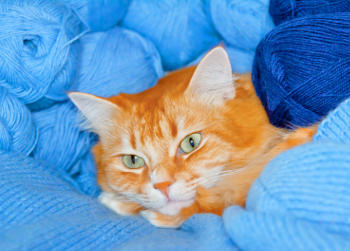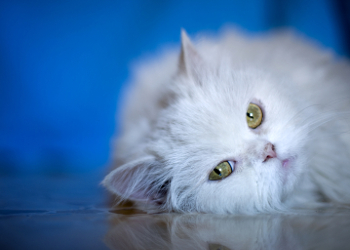Diseases #11

Diskosponylitis is an inflammation of the intervertebral disks and veterbral body plus adjacent tissues. The most common cause of this disease is a bacterial or fungal disease that reaches the nervous system via the blood. It is can also be reached by a septic process.
Diskospondylitis is most commonly seen in large breeds of dogs. Staphylococcus sp bacteria are often incriminated and once the bacteria arrive in the disk and vertebral space, inflammation and reproduction of organisms commences. Bone is destroyed or added and the spinal cord is eventually compressed leading to clinical signs.
One of the most common signs is acute back pain. This is due to the nearby meningitis caused by the bacterial infection. Fever may be present. As the infection and deformities continue, further neurological signs will progress including impairment of function mainly to the hind limbs. Signs are noticed in the posterior of the dog since most infections are localized in the lumbar or lumbosacral areas. Weakness and or unsteadiness of the gait is noticed and even inability to move the hindlimbs may occur.
Radiographs are taken to show the characteristic lesions. The verebral ends and disks will have a moth eaten appearance that appears due to the bone destruction and irregular bone deposition in the area. Blood and urine cultures will often identify the causing agent.
Diagnosis is made by the presentation of a large breed of dog with acute back pain. The history and physical, when combined with radiographs and cultures, will lead to a definitive diagnosis of diskospondylitis.
Treatment is geared towards long term antibiotic doses that have been selected from culture and sensitivity. Antibiotics have to be taken for at least 8 weeks with follow up radiographs to check the progress of the condition. Pain killers and anti-inflammatories are added to control pain. Severe cases will need further spinal stabilization.
The prognosis is dependent upon the response to long term antibiotic therapy and the actual initial severity of neurological signs. Even when the animal may be improving, diskospondylitis can effect other areas of the vertebrae and adjacent disks.




Canine Distemper is caused by a virus belong to the paramyxovirus family. It is extremely contagious and causes disease in dogs, coyotes, raccoons and wolves. Ferrets are carriers of the disease. Young animals that have not been vaccinated against the virus are at the highest risk of exposure.
Canine Distemper virus replicates itself initially in the lymphatic tissues of the respiratory tract, namely the tonsils. Replication extends to the lymphatic tissues of the digestive tract and central nervous system. As the levels of viremia (presence of virus in the blood) increases, clinical signs start to commence. The virus is transmitted by aerosol droplet from dog to dog. Infected bedding and secretions also transmit the virus to an unprotected dog.
Clinical signs arise from the location of viral replication. Young animals develop a fever of 103.0 F and higher. A respiratory cough is present along with watery, reddened eyes. Vomiting and diarrhea are also present. As the disease progresses the virus attacks the central nervous system resulting in neurological signs of crying out and uncontrollable seizure activity. Death occurs soon after the neurological signs. The disease is also called the "hard pad" diseases as some serotypes of the virus cause a thickening and or enlargement of the dogs foot pads.
A CBC will be done that shows a drop in the white blood cell count (mainly lymphocytes). This is typical of most viruses but will lead to a further weakening in the animal's still immature immune system. There are antibody tests available but most of them can not differentiate between disease antibodies produced and vaccination antibodies produced.
Diagnosis is made by noting the age and the vaccination status of a young animal presented with respiratory, digestive and or neurological signs. Most young dogs around 8-12 weeks that are presented (or develop) seizure activity, usually have Canine Distemper. Understanding where the animal came from also helps. If it was crowded in with other young animals such as a shelter, transmission may have occured there. Lab tests can be done and the virus isolated but most veterinarians diagnose it based on history and clinical signs.
There is no specific treatment for Canine Distemper. Symptomatic treatment is all that is available. Intravenous fluids, antibiotics, anti-vomiting and anti-diarrheal drugs are administered. Seizure activity can be slowed by the using of pentobarbital or facsimile. Once seizure activity starts, it is extremely difficult to completely stop.
The prognosis for most Canine Distemper patients is poor. Those dogs that do survive are never right again. The seizure activity may relapse and even if it does not many dogs have altered personalities after the seizuring has stopped. Many become afraid of people or strange surroundings.
Prevention is the key. Canine Distemper is one of the hallmark diseases that young animals are vaccinated against, starting at 6-8 weeks of age. Colostrum from vaccinated bitches provide some short term passive immunity, but puppies must go through a complete vaccine program to be totally immunized.




Feline Distemper is also known as Feline Panleuopenia. It is caused by a Parvo Virus. Let's be clear here. Cat Parvo virus is not transmitted to dogs nor is Dog Parvo transmitted to cats! Right after I graduated from veterinary school in 1981, Canine Parvo virus was out in full force. At that time, there were no vaccines for Canine Parvo virus. What we did at that time, was to vaccinate dogs against Parvo virus by using the Cat Distemper vaccine. That is all we had at the time! It worked though. Cats between the age of 2-6 months are the most commonly affected.
Feline Distemper virus disrupts the replication of blood cells at the level of the bone marrow and digestive tract. This can wipe out all white cell types as well as red cells. The latter can make the animal anemic and even weaker to the clinical signs of the virus. Since the immune system is severely weakened, the animal is susceptible to other bacterial and viral infections. This can debilitate the young animal even further.
Clinical signs shown are those caused by the associated place of viral replication. Vomiting, diarrhea, weight loss, dehydration, weakness, anemia, fever and neurological signs. Other generalized signs include anorexia and lack of desire to eat or drink. Extremely sick kittens, regardless of cause, will just sit scrunched up in a little ball and not move.
Animals can be infected while in utero. A queen that is pregnant can pass the virus to her unborn kittens. Those that survive in the third trimester are born with cellebellar hypoplasia. The cellebellum is responsible for maintaining balance and is located at the base of the brain stem. Virus replicates there and kittens walk in circles, totally unable to go straight. In severe cases, they will simply fall over. Cats are amazing creatures. Some of them that I have treated have learned to hold their heads at a particular tilt to get around. This always happens, as adults, in Feline Vestibular Syndrome.
A CBC will show a total drop in white cells as well as red cells. A chemistry profile can show internal organ development. The virus can be detected by using the Idexx® Parvo Snap Test.
A diagnosis of Feline Distemper is suspect when any unvaccinated kitten is presented with vomiting, fever and diarrhea. The presence of cerebellar hypoplasia is a give away for the disease making diagnosis easy. Combined with laboratory data, a diagnosis is made. The virus can be grown in a lab but most veterinarians base their diagnosis on the above. The Idexx® Canine Parvo Snap test is not manufactured for felines but it is accurate enough. Just keep in mind that it is a canine test kit.
There is no specific treatment for Feline Distemper. All treatment is supportive in nature. Antibiotics are given to prevent secondary bacterial infections. High caloric products like Nutrical® or Hill's® Prescription a/d are administered. Cats are rehydrated and treated for diarrhea and vomiting. As with many viral infections, the first 24-48 hours are crucial for survival.
The infection has an extremely guarded prognosis for the first day or so. Once cats start to eat and drink on their own, they will rapidly start gaining weight. This gives them more "heft" and indirectly helps build up their immune systems. With continued supportive care at home, animals can survive and have a life long immunity to the disease.
With all viral infections such as Feline Distemper, prevention is the key. All kittens should be vaccinated against Feline Distemper at 6-8 weeks of age and undergo a complete vaccine program. Even though survival confers life long immunity I still have vaccinated those animals for the Feline Distemper virus.
The virus is very easy to kill and will respond to dilute Chorox® disinfecting in close quarters where cats are found; such as groomers, boarding facilities and shelters.




Dystocia is a medical term that means difficulty giving birth to any young. The causes are numerous:
1. The uterus gets tired after straining for a long time. It is a muscle and can not effectively contract to expel the unborn animals. This is called uterine inertia.
2. Animals that are presented breach, perpendicular to the birth canal, can cause dystocia.
3. Hind limb delivery can block the birth canal with the hind limbs getting in the way.
4. Puppies can be too big. This happens when a larger male breeds with a small female or the pregnance goes on way beyond an expected due date.
There are three distinct stages of labor in the dog and cat. Dystocia can occur in any of the three stages:
1. The first stage is characterized by cervical dilatation and rupture of the amniotic fetal sac.
2. The second stage is the actual delivery and or passing of the fetus through the birth canal into the real world.
3. The third stage is the delivery of the afterbirth; known as the placenta. Dogs and cats are multiparous, that is they usually give birth to multiple fetuses. A female may pass one fetus than its afterbirth or pass two fetuses and one afterbirth and so on. There is no logic so owners have to be patient.
About 24 hours prior to the first stage of labor the body temperature in the dog (not cat) will drop to about 97 degrees F. The normal canine temperature is 102.0 F. That always indicates labor will start in about 18-24 hours. The female will appear restless, pace around, lay down in her whelping box and just be totally uncomfortable. Once labor begins, a fetus should arrive anywhere up to an hour or they may be born one after another in short order. Never let contractions go longer than 2-3 hours. If this occurs, placental abruption and separation occur and the fetus may be born stillborn.
Learn more about canine obstetrical care of the dog & cat.
Clinical signs of dystocia are readily observable. A female may undergo uterine contractions and all of a sudden stop those contractions. She may get up and act as if everything is done! This drop off in contractions can happen if nothing happens after the drop in body temperature, if she strains and strains and a fetus is not expelled after more than 3-4 hours of contractions. Giving birth causes a lot of pain. If there is a fetal obstruction somewhere, the animal may cry out in pain or constantly lick the vulvar area. Lastly, if a placenta is delivered prior to any fetus, this means that the placenta has separated from the fetus. Females will also have lots of problems delivering when the delivery date comes and goes THAN starts labor.
Lab work is often performed if a placental separation has occured. Decay of any fetus will start up a bacterial uterine infection (metritis) so a CBC may show an elevated neutrophil count. Radiographs and or an ultrasound may be performed to check the position and number of any remaining fetuses in the uterus. Chemistry profiles are necessary to check the general health status of the female plus needed if performing a Cesarean section under a general anesthetic.
Diagnosis of dystocia is made by obtaining a detailed medical history, if available, from the owner. A complete physical exam, including a gloved finger vaginal exam, is performed. Puppies caught at the cervical entrance can easily be palpated by this route. Any of the clinical signs and lab work pointing to dystocia lead a veterinarian to immediately treat the condition.
Treatment of dystocia is accomplished by 2 ways:
1. Employing drugs that stimulate the contraction of the uterus is the first thing done. The drug of choice is oxytocin. This chemical is usually produced in the posterior pituitary gland (along with ADH) and is the natural inducer of uterine contractions. Once an injection is given an animal may or may not start uterine contractions. If they do, and a fetus arrives, another injection may be offered to help deliver the remaining puppies. If all of this fails, surgery is the next step.
2. Cesarean sections are performed on all animals with persistent dystocia and no response to supplemented oxytocin. There is no other way. If a cesarean is not performed, placental separation will result in stillborns plus, if left in the uterine body, will result in metritis. The uterus may also rupture and require an emergency laparotomy. Even if the oxytocin does not result in uterine contractions, it will benefit the maternal mammary "milk letdown". When a newborn nurses, it stimulated the pituitary gland to release oxytocin. This allows the animal to successfully nurse.
The prognosis for rapidly diagnosed and treated cases of dystocia are usually excellent. During a Cesarean section if the fetuses are all still born, the mother is taken care of surgically and is discharged. Excess milk production and no fetuses to nurse, may lead to mastitis and or a mammary gland "blow out" that requires surgical repair.




The cause of ear mites is the mite, Otodectes cynotis. It is seen most commonly in cats as well as in dogs.
Ear Mites are extremely contagious in cats. They are spread by direct contact from one cat to another. Parasitized queens will pass the parasite on to their progeny so that entire litters of kittens may become infested. The ear mite is transmitted to the skin and has a direct predilection for tissues in the ear. It reproduces there and feeds on cellular ear debris and wax. If left untreated, ear mites can nibble at the tympanic membrane and cause hearing loss. Extreme scratching and head shaking can lead to an auricular hematoma in one or both ears. There is no direct transmission to humans.
Clinical signs produced are associated with the ear mite irritation in the effected ear. The cat or dog will scratch at the ear and shake its head a lot. Inside the external ear canal will be present a dark waxy material. This is ear wax mixed with the fecal matter of the mite. The mite irritates a cat so much that the tissues around the ear may be inflamed and hairless.
The most important lab work is taking a swab from a suspect cat and looking at it under the microscope. The mite is easily visible. They are small and white in appearance in the actual ear canal.
Diagnosis is made by the history, clinical signs and visualizing the ear mite directly in the ear canal or via a microscope slide smeared with otic debris.
There are many preparations that can eradicate ear mites. Pyrethrins and Tresaderm® have been used. One of the best products on the market is Acarrex®. This product contains ivermectin and is resolved with one treatment. Other topical products need to be used for at least 3 weeks. Some cases are difficult to get rid of. A trick of applying a drop or so of a topical to the tip of the cats tail is very effective in addition to the ear treatment.
Some topical flea medications can also eradicate ear mites in dogs or cats. Revolution® & Advantage® Multi are two of those products that work.
Some animals will require oral antibiotics and other therapy geared to controlling a secondary bacterial infection.
The prognosis for rapidly diagnosed and treated cats for ear mites is excellent. Treatment eradicates the parasite just once. A cat or dog can easily get reinfested if in continual contact with a carrier dog or cat. The prognosis for tympanic membrane hearing loss due to ear mites is guarded.

